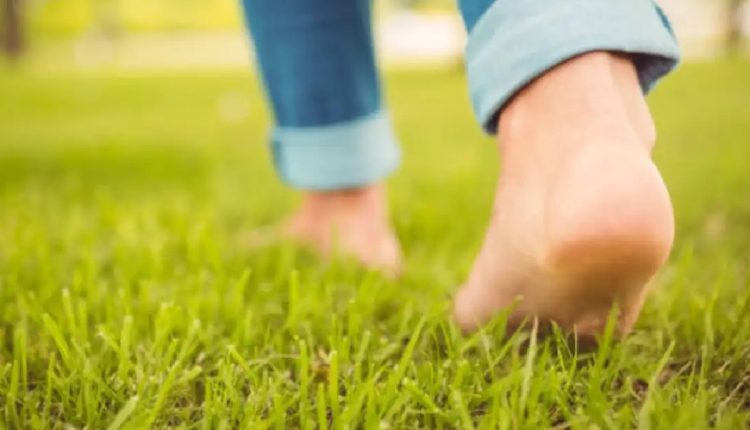When was the last time you walked barefoot on grass, sand, or soil? In today’s world of concrete pavements and cushioned footwear, our feet rarely touch the earth. Yet, ancient cultures have long believed in the healing power of going barefoot — a practice now supported by modern science under the term “earthing” or “grounding.”
Let’s take a step into nature — literally — and explore the incredible health benefits of walking barefoot.
1. Improves Posture and Balance
Your feet are the foundation of your entire body. Walking barefoot activates the small muscles in your feet, ankles, and legs, which often remain dormant inside shoes. This natural activation improves posture, balance, and alignment over time.
How it Helps:
-
Strengthens foot arches
-
Enhances sensory feedback to your brain
-
Reduces risk of falls in older adults
Try This:
Start walking barefoot for 10–15 minutes a day on safe surfaces like grass or smooth sand to build strength naturally.
2. Reduces Inflammation Through Grounding
One of the most fascinating benefits of barefoot walking is the concept of grounding — the idea that direct contact with the earth can reduce inflammation and oxidative stress in the body.
The earth carries a mild negative charge, and walking barefoot allows your body to absorb these electrons, which act as antioxidants and neutralize free radicals.
Research Says:
Studies show that grounding may:
-
Reduce markers of chronic inflammation
-
Improve immune response
-
Speed up recovery from muscle soreness
3. Enhances Sleep and Reduces Stress
Walking barefoot can actually calm your nervous system. The physical sensation of connecting with the earth, coupled with rhythmic walking, has a meditative effect that lowers cortisol (the stress hormone).
Reported Benefits:
-
Better quality sleep
-
Lower anxiety levels
-
Balanced mood and energy
Tip: Take a barefoot stroll in the early morning for a dose of both grounding and sunlight — a double boost for your sleep cycle.
4. Boosts Circulation and Nerve Sensitivity
When you walk without shoes, your foot muscles and nerves work more actively, which helps improve blood flow and restore nerve sensitivity, especially for those who experience numbness or tingling in the feet.
It also stimulates reflex zones (used in foot reflexology), promoting healing in various parts of the body.
5. Supports Natural Detoxification
Our feet are key exit points for toxins. Grounding is believed to enhance the body’s detoxification pathways by improving circulation and reducing stress, which can otherwise block natural elimination processes.
Combined with sweating and increased movement, walking barefoot helps your body flush out impurities more efficiently.
6. Strengthens Muscles and Joints Naturally
Shoes — especially those with high heels or thick soles — change your walking mechanics and reduce the natural mobility of your foot muscles and joints.
Walking barefoot:
-
Strengthens stabilizer muscles
-
Increases joint flexibility
-
Prevents flat feet and over-pronation
Over time, this can reduce the risk of injury, including ankle sprains, knee pain, and lower back discomfort.
7. Connects You to Nature and Mindfulness
Beyond the physical, barefoot walking helps reconnect us to the earth and the present moment. Feeling the grass, sand, or soil beneath your feet is a form of mindful walking — a practice used in meditation and mental health therapy.
Benefits include:
-
Grounded presence
-
Emotional balance
-
Enhanced body awareness
Even 5–10 minutes of mindful barefoot walking a day can improve your mood and clarity.
Where to Walk Barefoot Safely
If you’re new to barefoot walking, choose surfaces that are clean and natural, such as:
-
Freshly cut grass
-
Sandy beaches
-
Forest trails with soft soil
-
Wooden decks or stone pathways (with caution)
Avoid sharp, dirty, or overly hot surfaces to prevent injuries.
Precautions Before You Start
While barefoot walking is generally safe, keep in mind:
-
Start slowly to allow your muscles to adjust
-
Consult a podiatrist if you have foot injuries, diabetes, or balance issues
-
Always inspect your walking area for sharp objects
You can also try earthing mats indoors to simulate the effect if natural ground isn’t easily accessible.
Final Thoughts
Walking barefoot isn’t just a nostalgic throwback to childhood — it’s a powerful wellness tool hiding in plain sight. With every barefoot step, you’re not just walking — you’re healing. You’re activating muscles, grounding your energy, improving circulation, and inviting nature’s wisdom into your body.
So, kick off your shoes, find a patch of earth, and walk your way back to wellness.
Reconnect with the ground beneath you. Your body will thank you.
by [aruntrion]


Comments are closed.